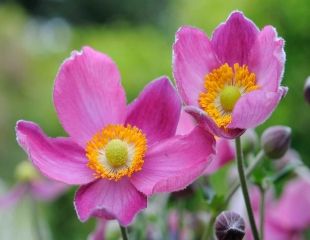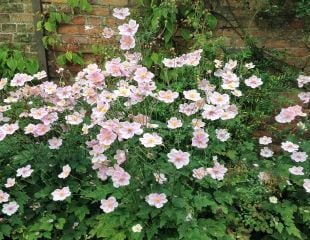


How to Grow Japanese Anemones
Key Facts:
Plant Type: Japanese anemones are a herbaceous Perennial
Height: Tall from 1-1.5m
Light: Will grow in sun, partial shade and full shade
Soil: Any except waterlogged
Maintenance: Fully Hardy, easy to grow, do not need staking.
Special features: lovely large saucer like in shades of pink, white and cream. They are vigorous and can be considered invasive. They spread by self seeding and rhizomes and can be hard to eradicate/thin out.
Where to plant Japanese Anemones
Plant Japanese anemones in an area of light or full shade that does not get too hot. Grow in soil which is well-drained soil and that does not become water-logged. Plants in winter may not survive. Japanese anemones grown in dense or dry shade may flower less. However, they are still attractive and a useful plant for difficult areas.
It can take a little time to get Japanese anemones established, but once they start flowering, they will do so reliably every year, and for a long flowering season. Japanese anemones are ideal for late colour in the border. Japanese anemones are among the longest-blooming and longest-lived perennials, remaining undisturbed in your garden for years.
The first frosts turn the foliage black, and at this stage, one can cut back the plants for the winter.
If planted in partial shade, Japanese anemones look good with tall ferns and the larger varieties of Hosta. They will also mix well with other late flowering perennials such as Asters, Sedum, and the tall Verbena bonariensis. Illustrated below is a lovely planting combination with grasses.
Pros and Cons of growing Japanese Anemones

The advantage of growing Japanese Anemones is that they will grow in all types of shade, partial, deep shade and even dry shade. Ideal for tricky, shady areas of the garden.
The downside is they are vigorous. You will never have just two or three plants!
The Japanese Anemones in the image are growing in my garden I recently moved to. The previous owners had planted the Anemones and left them to their own devices. There is a large clump growing in front of the trellis. Out of camera there is also a similar large clump established on other side of the trellis. In addition, the Japanese Anemones have also self seeded themselves all along a border close to the side of the house in deep shade.
Japanese anemones have gardening health warning and are best kept in check, periodically reducing to a tidy clump. There are many plants to dig out, and they are hard to eradicate. I cannot plant in that area, even once cleared, for a season or two. This is because I do not want Japanese Anemones popping up in the newly planted border. It's necessary to wait at least a season to check you have actually removed all the rhizomes and they are not coming back.
If Japanese Anemones aren’t quite your style, take a look at our Plants for Shade guide for more inspiration and ideas on what to grow in the shadier parts of your garden.
The Best Japanese Anemones for your garden.
.
A good starting point is varieties that have the RHS award of garden merit.
Anemone × hybrida 'Elegans' is a tall pale pink variety illustrated in the centre image.
Anemone Japenese anenome hupehensis Pamina is a darker pink and illustrated on the left.
Anemone Honorine Jobert is a lovely white variety illustrated left all three have the RHS award.
Anemone × hybrida 'Whirlwind' is awhite flowering variety said to spread less.
Suttons have a lovely selection of Japanese Anemones for sale ( affiliate link) including a collection of soft pink, magenta and cream blooms and the curiously named A. Frilly Knickers.

I have tagged Japanese Anemones green wheelbarrow because they are easy to grow (perhaps too easy) and maintenance free.
